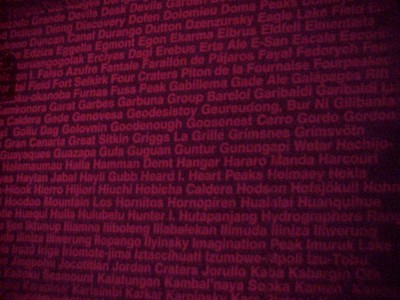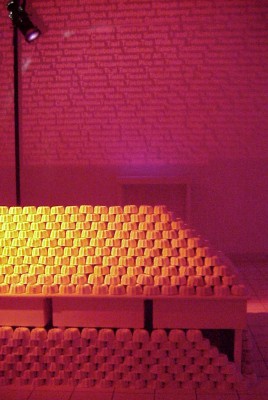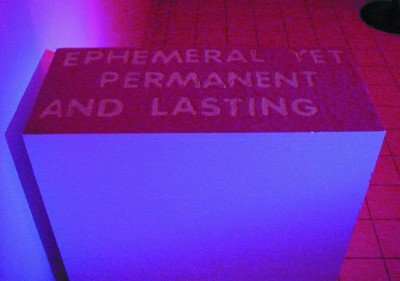Everythingness (Unfeeling) (2001)

Everythingness (Unfeeling) Installation view, Intar Gallery, NY, 2001
Everythingness (Unfeeling)is an installation based on research related to the culture of the drug ecstasy. The central installation consisted of 1500 multiples made of plaster, that were a hybrid between an ecstasy pill and a volcano. On the wall, the 1500 names of all the volcanoes in the world where projected. The installation was a reflection on both natural and artificial ecstasy, and the paradoxical relationship with time that the experience of ecstasy brings with itself (in the words of an ecstasy user: “ I have nostalgia for the moment I am living”). A sand writtend text welcomed the audience into the environment, with a quote by XVIIth century Spanish poet Francisco de Quevedo: “Ephemeral, yet permanent and lasting” (“Lo fugitivo permanece y dura”). A Van Der Graaf Generator in the end of the installation provided a soundtrack that pretty much replicated the feeling of a techno dance club, a common haven for ecstasy culture.
catalogue text by Franklin Sirmans (below)



Ephemeral (2001), sand
Pablo Helguera
Everythingness (Unfeeling)
“My soul was a burden, bruised and bleeding. It was tired of the man who
carried it, but I found no place to set it down to rest. It found no peace
in song or laughter, none in the company of friends at table or in the
pleasures of love, none even in books or poetry…. Where could I go, yet
leave myself behind?
-St. Augustine
“Let’s get high…,” Dr. Dre intones on his recent Grammy award-winning album
as countless other performers have bellowed before him. Pink Floyd likened a
similar effect to the sensation of being “comfortably numb.” While prayer
and comportment may lead to spiritual relief and even abundant contentment,
the quest to attain bliss comes in many secular forms-aside from a day at
the spa-legal and illegal. St. Augustine may have been looking for a natural
spiritual high but, since the beginning of time, people have looked to
mind-altering substances for soulful enlightenment.
In his compelling new installation “Everythingness (Unfeeling) Pablo
Helguera likens the paths of getting high (Everythingness) and experiencing
blissful numbness (Unfeeling) to the physical capability for eruption in
volcanoes. Metaphorical orgasms aside, this atomization of natural, physical
and mental sensation is made visible by text, object and image displayed as
a cohesive whole in the darkened space of the gallery. Rather than marijuana
or heroin, Helguera has selected ecstasy for its unique name that unlike
most other drugs implies euphoria in its linguistic designation. Ecstasy,
the feel good drug that makes you comfortable, friendly, and happy also
connotes the bodily sensation of ecstatic physicality, conjuring an extended
space in time for the orgasmic moment of sex. The extended moment captured
by the drug represents the place where everything is attainable, or at least
the feeling that everything is attainable. The fact that Helguera’s title
implies the ambiguity of such a thing is the point. To have everything may
be to feel nothing.
Helguera, like Fred Wilson, has long pursued an institutional critique by
employing varied elements of display-cabinets of curiosity, live performance
and music-akin to natural history museums and theater. In the process he has
found ideal media to explore social and cultural issues often through
biographical narratives weaving fact and fiction and mixing up art and
artifact. As much as Helguera’s art is about art historical precedents and
the institutional structures of museums, his art is about people, or the
all-encompassing “humanity,” in a cultural epoch where it all feels
manufactured to dull our belief systems in anything. Inspired by a
philosophical inquiry into the nature of human behavior, Helguera began the
ongoing Everythingness series last year presenting a fictional corporation
that commodified time for sale. The style and form of high-production
advertising was coopted to challenge the insipid banality of corporate
imagery. This second part, Everythingness (Unfeeling) is about capturing and
controlling the human spirit. Bombarded by artificial stimuli, such as the
violence of video gaming, unabashed sex selling everything from beer to
toasters, and the universal standby, drugs, Helguera’s work highlighs our
attempts to harness and utilize these potentially powerful experiences to
control our level of happiness.
As in past works, Everythingness (Unfeeling) comes from a strategy of
investigation that places emphasis on an archive of narratives both lived
and invented, given synergy by their placement together as a new whole. Yet,
unlike those past text-driven works, for the first time, Helguera has placed
his faith first and foremost in the value of the images to direct the story.
1,500 plaster casts cut from Jello molds represent the amount of existing
volcanoes in the world, displayed on hanging platforms with a registry of
the volcanoes projected onto the wall. “Ephemeral, yet permanent and
lasting,” the words of the Spanish 17th century poet Francisco de Quevedo,
reads the powdered text on a pedestal nearby, reminding us of the Sisyphean
commitment to getting high, which maintains that more, and more is a
necessary tenet. A testimonial of experiences with ecstasy and other drugs
is drawn out with small capsules resembling the drug: “I had nostalgia for
the moment I was living. I experienced a kind of wordless glory. This was
the best I’d ever felt in my life. The static passing of a Saturday
afternoon had been broken.” If this sounds formally tame, there’s an eerie,
reddish video image of burning oxen and a techno music soundtrack further
emphasizing the contested space between the real and the emotionally
supernatural realm of euphoria. Sometimes we forget that the world of the
plastic visual arts is as much a place of wonder and fantasy-suspended
belief- as that of contemporary film, music and television. It is not
forgotten here. The cacophony of sound, text and image provide the
atmosphere to recall or at least challenge tropes of happiness and their
relation to everythingness.
As a performance artist, visual artist and scriptwriter, Helguera is keenly
attuned to the displacement of value in cultural production. His
installation evokes the myriad ways in which installation art has mutated
from Kurt Schwitter’s 1923 house installation to the social critique of
Alfredo Jaar, to Cecilia Vicuna’s displacement of nature in the gallery, to
Barbara Kruger’s textual interventions and the most recent hypermedia-wired
atmospherics of more recent installation art. Within these formal confines,
he has visualized “Everythingness (Unfeeling)” successfully leaving us with
more questions than answers. How do we visualize ‘everything’? What is a
state of ‘everythingness’ or having it all? For Pablo Helguera,
‘everythingness’ is a critical fiction-a politics of the imagination-and
like the quest for Spiritual Enlightenment, ‘everythingness’ is a radically
contested subjective space where we are looking for more of something we
feel we don’t have-to control the uncontrollable in a world where paradox
rules.
Franklin Sirmans